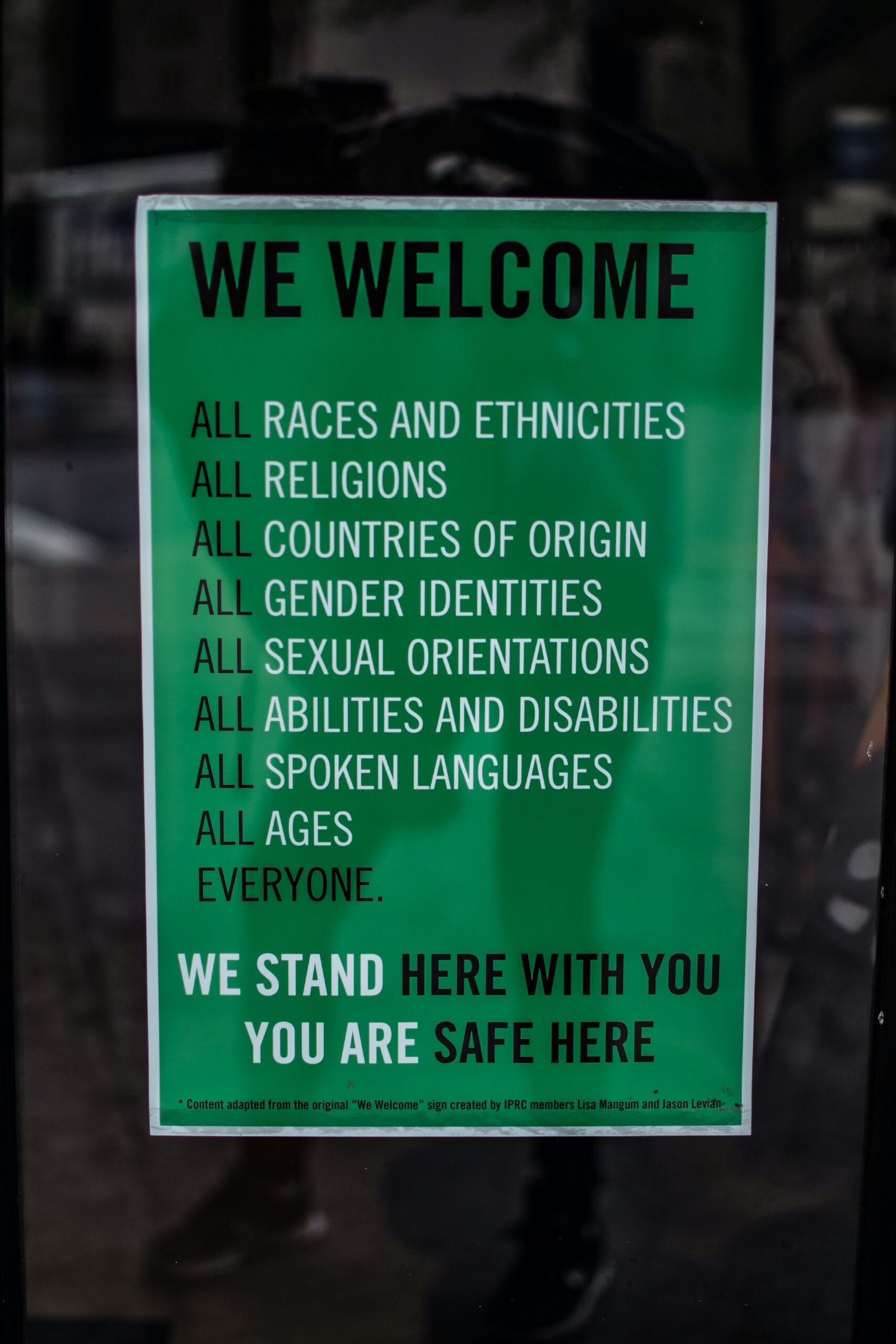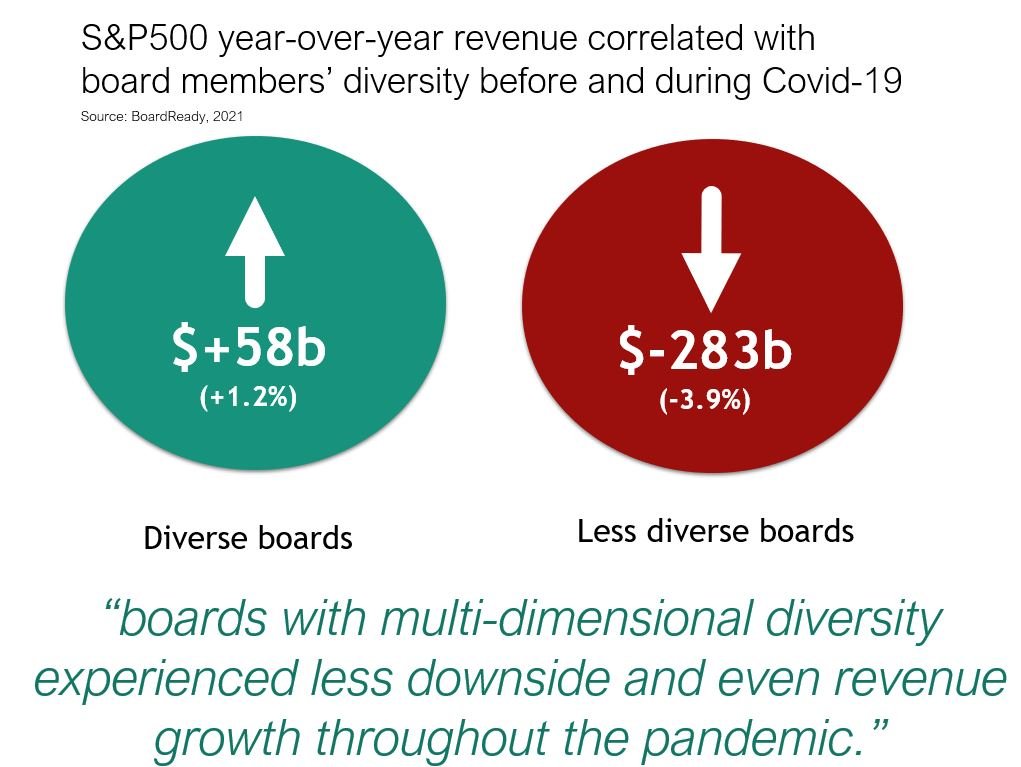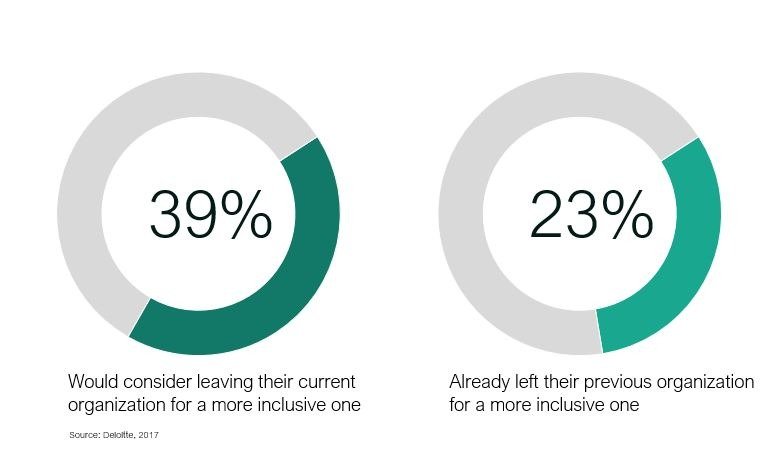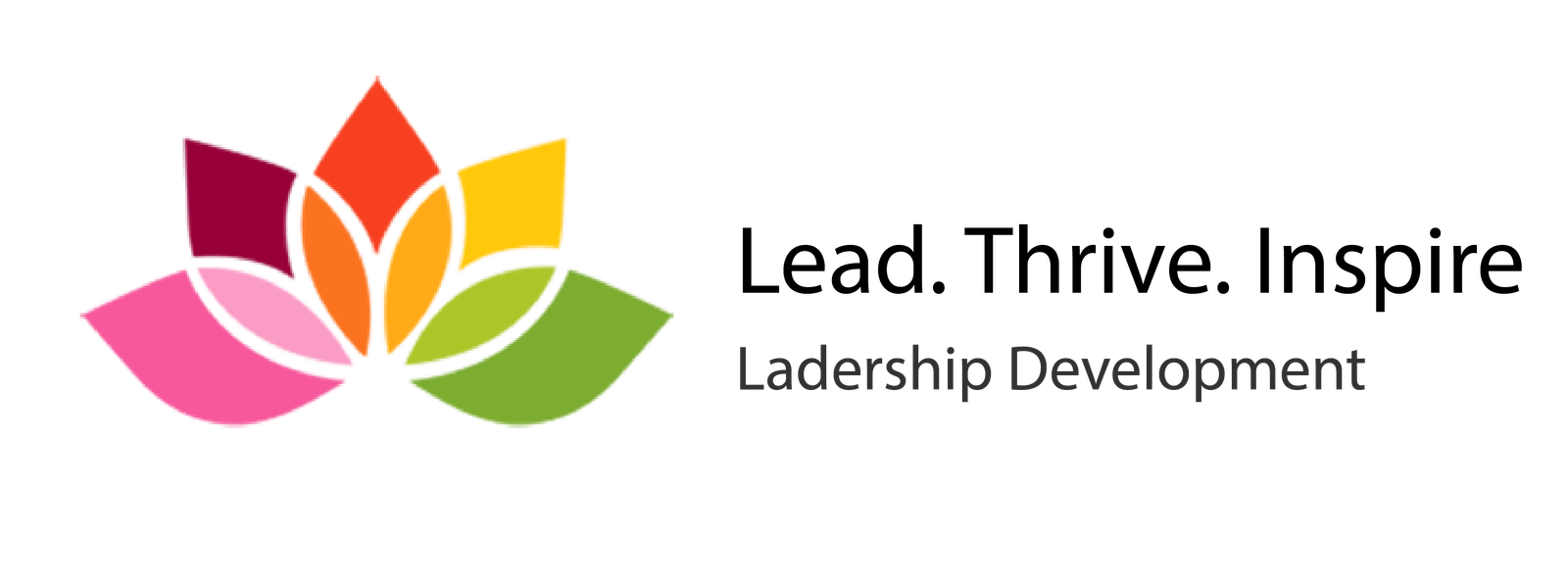
This article reviews the current literature relating to the business case of Diversity, Equity and Inclusion (DEI). This is the 3rd part of a 3 part series on DEI
In recent years market-leading organizations have recognized the importance of Diversity, Equity and Inclusion (DEI). Yet, while the business case for DEI continues to gain strength with new research literature, surveys and market analysis added each year, a recent study [1] demonstrates that only 12% of the organizations actually achieve DEI in its highest form.
Whereas managers are still treating DEI-related issues as compliance tasks rather than business-critical goals to be achieved, there is a growing number of studies showing that DEI, when implemented correctly, can lead to an increase in the three primary hard-core business goals: (1) profitability & performance, (2) innovation, (3) and employee recruitment, retention and engagement.
-
Profitability & Performance – let’s focus on the bottom line
Organizations thrive, survive or die based on their bottom line, and contrary to common belief, DEI could be an essential profitability and performance booster. Most people would agree that diversity of qualification is a must in any modern-age organization. You could not print a newspaper with only writers, no matter how skilled and talented they were. Likewise, you would not imagine building a plane having welders, engineers, and designers by your side. However, in today’s world in order to profit and perform at your best, there is also a need for social diversity. Teams of diverse ethnicities, cultures, genders and others achieve higher profits and perform better, especially during times of crisis and transition.
A 2021 study analyzed the correlation between S&P500 board members’ diversity and their performance before and during Covid-19. The study found a 9%-point increase in the likelihood of positive year-over-year revenue growth in 2020, an increase in company revenue for the more diverse companies compared to the less diverse ones. While all 500 companies experienced a lower revenue due to the pandemic, their year-over-year revenue grew overall by $58 billion (+1.2%), for the more diverse companies, versus a $283 billion drop (-3.9%), for the less diverse ones, leading the report to conclude that “boards with multi-dimensional diversity experienced less downside and even revenue growth throughout the pandemic.”[2].

Other studies demonstrate that organizations with diverse, equitable and inclusive cultures are twice more likely to exceed their financial target [3], and a 2019 McKinsey report determines that the top quartile of the DEI organizations are 36% more likely to achieve a financial performance above the national industry median as compared to the lowest DEI quartile, when it comes to ethnic diversity, and 25% higher likelihood when considering gender diversity [4]. Studies also show that teams with inclusive leaders are 17% more likely to report higher team performance [5], 20% more likely to say they make higher-quality decisions, and 29% more likely to report more team collaboration [6]. In addition, when it comes to performance, research shows that diversity leads to quicker solution finding [7] and lower groupthink [8].

-
Innovation
While profit and performance goals are the engines that keep the boat afloat, if the company’s innovation rudder is missing, the organization may face an imminent risk of running aground. Vivid examples of giants who led the market for years until failing to innovate are the likes of Nokia, Xerox, Kodak, Blackberry or Blockbuster.
It turns out that DEI has a significant effect on organizational innovation and creativity, mainly due to diversity of thought.
Let’s start by stating the obvious, building diverse cultures is not easy, but working in diverse teams could sometimes be even more challenging. When all the team members have gone to the same school, know the same songs, read the same news and hang out in the same places, it is often so much easier to communicate and coordinate and, well…simply put, feel more comfortable. Yet, this feeling of familiarity and comfort goes against our creativeness. It turns out we become more innovative and smarter when we work in those diverse and “uncomfortable” teams. The very need to search for novel routes and perspectives of different races, genders, cultures, age differences and other dimensions is what makes us grow, and as a result, we become better decision-makers, better problem solvers and better innovators.
The late Prof. Katherine Phillips, who studied diversity for several decades, has repeatedly observed in her research that “being around people who are different from us makes us more creative, more diligent and harder-working…We need diversity if we are to change, grow, and innovate” [9,10].
Recent studies have shown that organizations with a higher-than-average DEI have 19% points higher innovation revenue than the lower-than-average companies [11]. Moreover, a study of over 4000 companies [12] found that gender diversity in R&D teams is positively correlated with radical innovation, and a study of over 7600 companies in London found that more diverse leadership teams are more likely to introduce new product innovations [13], as compare to the more homogenous ones.
Additionally, a 2013 survey comprising 1800 professionals found that employees working in more diverse companies are 70% likelier to report that their firm has captured new markets in the previous year and 75% more likely to see innovative ideas become productized [14].
And finally, a 2016 survey by Deloitte confirms that organizations with inclusive cultures are six times more likely to be innovative and six times more likely to anticipate change and respond to it effectively [5].
-
Employee recruitment, retention and engagement – Winning the war for talent
In our fast-paced world, recruiting, retaining and engaging the right talent is increasingly complex. As the saying goes: In the war for talent, talent has already won.
Finding the right talent cannot be understated. Research dating back as far as the late ’60s demonstrate a 10x performance gap between good and bad programmers [15], this research was later generalized, stating that “the top 20 percent of the people produced about 50 percent of the output, whether the output is touchdowns, patents, solved cases, or software [16].
Although there is no silver bullet, DEI has proven to be a powerful tool for attracting and retaining talent.
Companies leaning into diversity often start by looking for talent outside their immediate comfort zone. Both an international bank and a start-up company I recently worked with on DEI realized they were constantly recruiting candidates from a very limited pool of resources (mainly graduates of a few well-known universities). When they eventually expanded the scope of their search, they quickly realized they were capitalizing on new and untapped talent resources. Additionally, in a recent survey of over 1300 employees, 80% of respondents said inclusion is an important factor for them when choosing an employer, an answer that was true for millennials as well as boomers. Moreover, the number one answer (47%) to the question, Which aspect of work culture do you value most when choosing an organization for which to work was: “An atmosphere where I feel comfortable being myself” [17].
While hiring the right talent is important, it is often not enough. In 2019 alone, over 42 million employees quit their jobs in the US (almost 25% of the US workforce). Studies suggest that when employees quit, their companies spend an average of 21% of their annual salary due to loss of productivity, recruitment and training expenses for their replacements. Furthermore, in the case of high-paid executives, the turnover expense could reach up to 200% of their annual salary [19]. This makes attempts to reduce employee and executive turnover a major business priority.
Whereas the recent pandemic caused a temporary decrease in turnover, today, as Covid begins to recede, studies show that turnover rates are continually increasing and suggest they continue to grow in the following months and years [18]. If anything, the pandemic has nudged people towards new perspectives of choosing life, meaning and personal values over unsatisfying workplaces. Simply put, employees today expect from their employers more than a fridge full of free sodas and some gym perks. A survey collecting employee’s 3 top workplace values indicates that employees today want their organization to accept their authentic selves at work, allow work-life flexibility and make a purposeful impact in and on the world [17]. Similarly, in a recent Deloitte survey, 39% of respondents reported they would consider leaving their current organization for a more inclusive one, while 23% reported already having changed their jobs to more inclusive ones [17].

Some final words
Many managers today understand the need for greater DEI yet feel a tension between “doing the right thing” vs. making profit. This tension often leads to actions such as hiring “Diversity Officers”, holding large DEI events or printing beautiful posters in favor of DEI, without meaningful and tangible actions to back it up. As this article demonstrates, the paradox is that the more Diversity, Equity and Inclusion is incorporated into your organizational culture the better the financial returns are, through enhanced performance, innovation, and employee engagement. As a first step, in order to implement DEI in the organization it is imperative to assess your current DEI level and then focus on applying the best DEI practices to move the DEI needle forward.
Resources:
[1] Stacia Sherman Garr and Candace Atamanik, High-impact diversity and inclusion, Bersin by Deloitte, forthcoming, April 2017
[2] Lessons From The Pandemic, Board Diversity and Performance
[3] Bourke, J. (2016). Which Two Heads Are Better Than One?: How Diverse Teams Create Breakthrough Ideas and Make Smarter Decisions. Australian Institute of Company Directors.
[4] Hunt, V., Prince, S., Dixon-Fyle, S., & Dolan, K. (2020). Diversity wins. McKinsey.
[5] Bourke, J., & Dillon, B. (2018). The diversity and inclusion revolution: Eight powerful truths. Deloitte Review, 22, 82-95.
[6] Bourke, J., & Espedido, A. (2019). Why inclusive leaders are good for organizations, and how to become one. Harvard Business Review Digital Articles, 1(1), 2-5
[7] Reynolds, A., & Lewis, D. (2017). Teams solve problems faster when they’re more cognitively diverse. Harvard Business Review, 30
[8] Homan, A. C. (2019). Dealing with diversity in workgroups: Preventing problems and promoting potential. Social and Personality Psychology Compass, 13(5), e12465
[9] Phillips, K. W. (2014). How diversity makes us smarter. Scientific American, 311(4), 43-47.
[10] How Diversity Empowers Science and Innovation, State of the World’s Science 2014.
[11] Lorenzo, R., & Reeves, M. (2018). How and where diversity drives financial performance. Harvard Business Review, 30, 1-5.
[12] Díaz-García, C., González-Moreno, A., & Jose Saez-Martinez, F. (2013). Gender diversity within R&D teams: Its impact on radicalness of innovation. Innovation, 15(2), 149-160.
[13] Nathan, M., & Lee, N. (2013). Cultural Diversity, Innovation, and Entrepreneurship: Firm‐level Evidence from L ondon. Economic Geography, 89(4), 367-394.
[14] Hewlett, S. A., Marshall, M., & Sherbin, L. (2013). How diversity can drive innovation. Harvard business review, 91(12), 30-30.
[15] Sackman, H., Erikson, W. J., & Grant, E. E. (1968). Exploratory experimental studies comparing online and offline programming performance. Communications of the ACM, 11(1), 3-11.
[16] Augustine, N.R. “Augustine’s Laws and Major System Development Programs.” Defense Systems Management Review, 1979, pp. 50-76.
[17] King, B. J. (2017). Unleashing the Power of Inclusion. Attracting and Engaging the Evolving Workforce. Deloitte Development LLC.
[18] Nelms , D. (2020), Voluntary Turnover Returns as COVID Recedes
[19] Boushey, H., & Glynn, S. J. (2012). There are significant business costs to replacing employees. Center for American Progress, 16, 1-9







